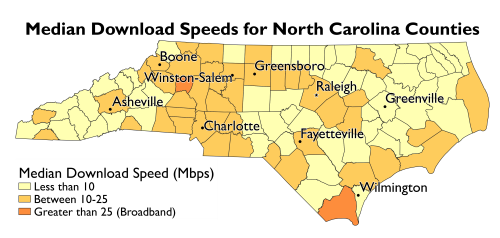
Too many in North Carolina lack fast, affordable, and reliable Internet access. You may be one of them. Lack of good broadband access hurts the entire state, leaving businesses less competitive, children with fewer educational opportunities, and everyone frustrated with not having a better option for an essential service in modern life. We can do something about it.
While federal data about broadband paints a rosy picture of access, this map reveals the simple truth that most people are using the Internet at slow speeds – and probably paying too much to do so. Based on more than 2 million speed tests across the state, only a few counties have a majority of connections that exceed what the Federal Communications Commission would call broadband. If you take our speed test, you can share your location so we can track it within the county, creating a better data set.
More importantly, you can take action to help North Carolina achieve universal access to fast, affordable, and reliable Internet access. And we need your help.

The single greatest barrier to expanding broadband Internet access where it isn’t – and competition where it is – is with local solutions. The state and federal government don’t even know where the problem is, let alone how to solve it. But communities can, whether with local investments, partnerships, or other innovative strategies. North Carolina law discourages local solutions, a policy that big out-of-state companies like AT&T and Charter Spectrum are working hard to maintain.
Our goal is to help educate North Carolina residents, businesses, and activists on the role communities can play to expand local Internet choice — and then implement some solutions! Please sign up to stay informed.

WRAL produced this important documentary about broadband in North Carolina and released it in March, 2020.

This short documentary explores a unique approach from a community in Idaho to expanding the highest-quality Internet access and encouraging innovation with local Internet Service Providers. It’s a reminder of why communities should be able to solve problems locally, in a manner consistent with local culture.

